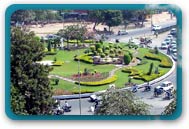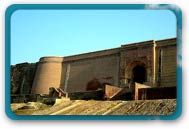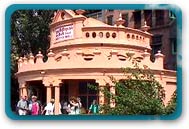|
 |
|
|
|
|
|
|
|
|
|
|
|
|
|
|
|
|
|
| Exploring Monuments of Delhi |
|
|
| About Delhi |
|
|
 |
|
| Travel Destinations Guide |
|
|
| Adventure Tours India |
|
|
|
|
 |
Biking Tours |
 |
Paragliding |
 |
Skiing |
 |
Safari Tours |
 |
Water Rafting |
 |
Trekking Tours |
 |
Camel Safari |
|
|
| |
|
|
|
|
|
|
|
|
|
| Temples of Delhi |
|
|
 |
|
| Historical Forts of Delhi |
|
|
|
| Punjab - The Green Grainary of India |
|
| Back |
Cheer up your vacation with the people who know how to share the best. Bubbling with immense cordiality, they teach every tourist a lesson to live life. Besides, Punjabis are extremely industrious and respect the ladders of labour, making this one of the most prosperous states in India. One should not forget that Punjab is the first state that adorned itself with the colours of Green Revolution. With a massive public investment and a superb irrigation and modern agricultural methods, Punjab led the country's Green Revolution of the 1960s thereby earning for itself the onyma of becoming India's 'bread basket'. Visit their lush green farms and then refresh yourself with a glass of chilled 'lassi' (buttermilk). Don't forget to savour the delicious 'mah ki daal', 'sarson da saag' and the mind-blowing 'makki di roti'. With all these and much more to explore, Punjab attracts hundreds of tourists round the year to its golden temple at Amritsar with a promise of extraordinary culinary delight.
  Amritsar Golden Temple Amritsar Golden Temple
Despite its great sacred status, the Golden Temple is open to visitors, like all Sikh temples. The only restrictions are that visitors must not drink alcohol, eat meat or smoke in the shrine. And unlike many other Indian temples, visitors to the Harmandir Sahib are made to feel truly welcome and not pressured to buy anything. The information office left of the main gate gives helpful advice and information, as well as booklets on Sikhism.
Most visitors to the Golden Temple, whether Sikh or not, are humbled by what is quite simply the most tangibly spiritual place in the country. Arrive with a few good hours set aside and get lost in its magical beauty. Visitors must leave their shoes at the facility near the entrance, cover their head (bandanas are provided, or you can buy a souvenir bandana from a vendor), and wash their feet by wading through the shallow pool before entering.
The most famous and sacred part of the Golden Temple complex is the Hari Mandir (Divine Temple) or Darbar Sahib (Court of the Lord), which is the beautiful golden structure at the center of a large body of water. The gold-plated building features copper cupolas and white marble walls encrusted with precious stones arranged in decorative Islamic-style floral patterns. The structure is decorated inside and out with verses from the Granth Sahib (the Sikh holy book).
The water that surrounds the Hari Mandir is a sacred pool known as the Amrit Sarovar (Pool of Nectar). The temple is reached by following the Parikrama, which circumscribes the sacred pool in a clockwise direction. Connecting the pathway with the Hari Mandir is a marble causeway called the Guru's Bridge, which symbolizes the journey of the soul after death. The gateway to the bridge, the Darshani Deorhi, has magnificent silver doors.
The fascinating scene inside the Hari Mandir is televised throughout India for Sikh viewers. Amidst a crowd of fervent and solemn devotees, scriptures from the Holy Book are sung beneath a canopy studded with jewels. A chauri (whisk) is continually waved above the Book as lines of Sikhs pay their respects by touching their foreheads to the temple floor and walls, continuing in a clockwise direction at a relaxed pace.
Another major highlight of the Golden Temple complex is the Guru-ka-Langar, a dining hall where around 35,000 people a day are fed for free by temple volunteers. Everyone is invited to join this communal breaking of bread. All participants sit on the floor, regardless of caste, status, wealth or creed, powerfully symbolizing the central Sikh doctrine of the equality of all people.
Guest quarters are also available for international Sikh visitors (for a nominal fee), and at least 400 simple rooms are provided (free of charge) to Sikh pilgrims.
In the Central Sikh Museum at the main entrance, galleries display images and remembrances of Sikh gurus, warriors, and saints; it includes some graphic portraits of the torture and execution of gurus.
 Life In Punjab Life In Punjab
 The land of Punjab which is described as the land of the Gurus, Pirs and the warriors, as a matter of faith believes in earning honest living through hard labor and in sharing the fruits of this labor with others without expecting any returns. Green fields, fields ripe with corn, tractors busy with work; Punjab presents a pretty picture of a prosperous farm life. The culture of Punjab from among the cultures of the world has its own unique fragrance. It is unmatched. The scent of this fertile land is such in which the warmth of you-are-my-own is inborn. All communities hold pride in their traditions.ife. A guest in Punjab is considered as a representative sent by God. The land of Punjab which is described as the land of the Gurus, Pirs and the warriors, as a matter of faith believes in earning honest living through hard labor and in sharing the fruits of this labor with others without expecting any returns. Green fields, fields ripe with corn, tractors busy with work; Punjab presents a pretty picture of a prosperous farm life. The culture of Punjab from among the cultures of the world has its own unique fragrance. It is unmatched. The scent of this fertile land is such in which the warmth of you-are-my-own is inborn. All communities hold pride in their traditions.ife. A guest in Punjab is considered as a representative sent by God.
The first impression of Punjab one gets is that of a land pulsating with prosperity. The plains of Punjab, with their fertile soil and abundant water supply, are naturally suited to be the breadbasket for India. The land of five rivers is a land of exciting culture, myriad images of swaying emerald green fields and hearty people whose robust rustic ways of camaraderie and bonhomie are very much a part of their heritage. Today's Punjab has become a land of boundless opportunities, offering distinct advantages for investment and industry. Since the recent liberalization of India's economy, Punjab has started making its mark on the global business mainstream, with major players from around the world forming joint ventures in the field of agri-business. Today's Punjab has over 1.97 lakhs of small and medium industries and about 653 large-scale industries. It leads in the manufacture of machine and hand tools; printing and paper cutting machinery; auto parts and electrical switchgear.
The state also provides more than 75% of the country's requirement for bicycles, sewing machines, hosiery and sports goods. At par with the highest quality standards in the world, these products have carved a niche for themselves in markets across the globe. Its average growth rate of 10% is amongst the highest in the country, clearly reflecting the progressive economy of the state. Punjab also boasts a 58% literacy rate and the highest per capita income in India.
  Chandigarh Chandigarh
Chandigarh is the best-planned city in India, with architecture which is world-renowned, and a quality of life, which is unparalleled. As the capital of the states of Punjab and Haryana, and the Union Territory of Chandigarh it is a prestigious city. The face of modern India, Chandigarh, is the manifestation of a dream that Pt. Jawahar Lal Nehru envisaged and Le Corbusier executed.
Serenity and a city are two diametrically opposite concepts, which however, get belied in the 'City Beautiful'. Chandigarh is a rare epitome of modernization co-existing with nature's preservation. It is here that the trees and plants are as much a part of the construction plans as the buildings and the roads. India's first planned city, is a rich, prosperous, spic and span, green city rightly called " THE CITY BEAUTIFUL ".
 Five Rivers & Prosperity Five Rivers & Prosperity
Punjab- the land of five rivers- has been the chief food grain producer of India. Spread across 50,362 sq km, the state is located in the north-west part of India, sharing its borders with Pakistan, Jammu & Kashmir, Himachal Pradesh, Haryana and Rajasthan. The agriculturally rich land of Punjab is rinsed by five rivers -Zhelam, Raavi, Chenab, Satluj and Beas. These water bodies gave the state its name, and its enterprising people gave it its fame of being the 'Granary of India.' Punjab is among the few prosperous states of India, where agriculture and industry have both made significant strides.
The geography of Punjab also played its role in the state's prosperity; most of the Punjab lies in a fertile plain, and only towards the southeast one can come across semi-arid and desert landscape. However, Punjab is not only about green revolution and entrepreneurship spirit, which have helped it to earn the distinction of having the highest per capita income in India. It is as a much a state of agriculture as it is of culture.
The history of Punjab has witnessed several cross-cultural influences, which have helped to shape up its cultural mosaic. The state's pluralistic cultural legacy is not only manifested through its various exuberant festivities -Baisakhi being the chief among them- and historic attractions, but also through its rich body of music and literature.
  Legacies of Punjab Legacies of Punjab
The state of Punjab is often known as the land of soldiers. The history of Punjab has its roots in the Harappan civilization. A state known for its forts, palaces and archaeological sites, it is a must see during your India itinerary.
Once the tourists visit this picturesque state they can explore the myriad legacies of Punjab, which not only includes forts and palaces but legends and tales about great people. Maharaja Ranjit Singh, Bhagat Singh and so on are the sons of this soil. These great personalities have written the name of the state of Punjab in golden letters.
Forts like the Govindgargh Fort, Bhadurgargh Fort, etc. are the integral parts of legacies of Punjab. The forts built in the various parts of Punjab, played an important role of protecting the land. The great Bhatinda Fort showcases the intelligence and vision of its builders. Located in the sandy deserts, the fort is built in the shape of a ship. Hence the fort is popularly known as the ship of the desert. Others like the Faridkot Fort are said to be 700 years old. The Sheesh Mahal built in the interiors of the fort, is famous for its glass and crystal decorations. This hall was the royal prayer room of the kings and the queens. The Sheesh Mahal reflects a distinct Rajasthani style in its architecture.
  Temples of Punjab Temples of Punjab
Temples of Punjab unveil the splendid architectural skills of the artists of the bygone era. Surrounded with serenity, these temples provide eternal peace of mind and soul for the devotees who come here. Captivating the spirit of human beings, the temples cast a spell on its devotees to experience the divine presence of the Almighty.
The Sodal Mandir is one of the holiest Temples of Punjab. This sacred place of child divinity allures many people to this temple, as it is believed that the prayers at this temple are answered. Ram Tirth temple has created a proud history for itself and is one of the prime Temples of Punjab. Ram Tirth temple lies at an approximate distance of 11 kilometers to the west side of Amritsar. This temple is the residence of the legendary writer of Ramayana, Rishi Balmiki. This temple houses an old tank and numerous other temples. The places that highlight the importance of Ram Tirth are bathing place of Mata Sita, the hut where Luv and Kush were born, and the residence of Rishi Balmiki. The four-day festival that is celebrated at this temple mirrors the glorious historical past of this city. The revered Bhagwathi Mandir is located in a small village, Khana, and unveils great architectural skills of the artists of yore. The enigmatic myth behind the construction of this huge monument in this small village often leaves the tourists fascinated. The village people believe that Goddess Bhagwathi Mata listens to the prayers that are offered at this temple. The construction of this temple is marked with the celebration of a grand fair, which is celebrated for four days. This is one of the important Temples of Punjab having great religious significance, and it is thronged by the devotees of Goddess Bhagwathi Mata.
Exploring the spirituality of Punjab through its temples can be a great experience for the people visiting Punjab. The construction of the venerated Durgiana Mandir is influenced by the architecture of the Golden Temple. This is one of the splendid Temples of Punjab that echo the age-old religious traditions.
Temples of Punjab
are:
Bhagwathi Mandir
,
Durgiana Mandir,
Kali Devi Temple
,
Panch Mandir
,
Ram Tirth
,
Shiv Mandir
,
Golden Temple
 Fairs And Festivals Fairs And Festivals
Basant Panchami at Chheharta Sahib :
Basant Panchami is celebrated with great enthusiasm at Gurudwara Chheharta Sahib on fifth day of the bright half of the month of Magh (end of January or beginning of February). People start pouring in a day earlier than the Basant Panchami and participate in the celebrations, which starts the same evening.
Ram Tirath Fair : Ram Tirath is located about 11 km to the west of Amritsar city on Amritsar Lopoke road. It is an ancient pilgrimage centre associated with the period of Ramayana. It is said that Sita spent her period of exile at this place in the cottage of Rishi Balmik.It was here that twins were born to Sita who were named as Lav and Kush.
 Sikh Religion - An Universal Cult of Brotherhood Sikh Religion - An Universal Cult of Brotherhood
The Sikh religion, which originated in Punjab, is based on the teachings of Guru Nanak, and is conceived as a monotheistic faith, whose adherents, the Sardars, at present can be found all over India and abroad too. Its insistence on the universal cult of brotherhood, its plea for equitable social and spiritual liberties for all types of men, its emphasis on the service of man on the road of strong moral codes and, above all, its recognition of the divinity of man and the need of meditation have made Sikhism a subject of great interest across the world. All Sikhs venerate the Guru Granth Sahib, a holy book that contains 'Gurbani', the preaching of Guru Nanak. If you happen to visit a Sigh marriage during your vacation in Punjab, you can see the bride following the groom four times round the Guru Granth Sahib while prayers are sung and hymes are read from the holy book. |
| Back |
|
|
|
|
|
|
|
|
|
|
|
|
|
|
